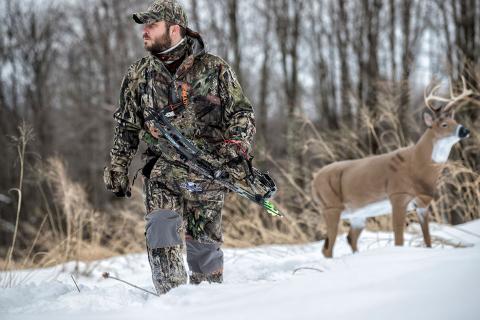Todd Amenrud | Originally published in GameKeepers: Farming for Wildlife Magazine
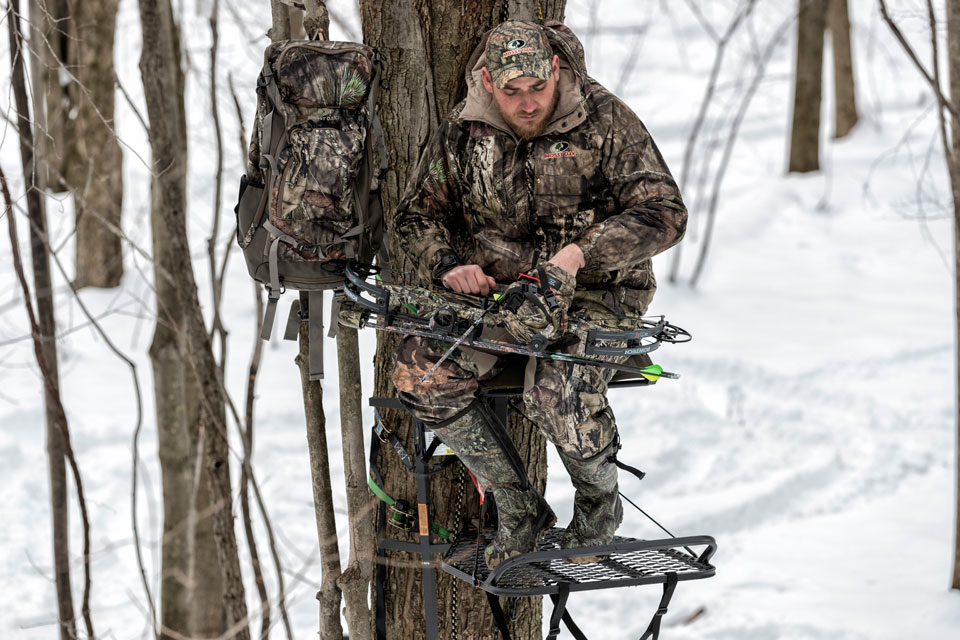
If you hunt whitetails, you probably own one or more treestands. Whether you hunt with a bow or gun, more whitetails are tagged each year from a treestand than by any other means. It's a very important piece of equipment for a gamekeeper, but which type of treestand is right for you, your property, your topography and your preferred hunting style? We have climbers, fixed position portables, ladders, tripods, free-standing platforms, tree-seats and crotch-stands – and there are scores of each to choose from. Personal preference, cost and practicality are deciding factors. Yet, each category has a place where it shines and is the best choice for a distinct set of circumstances. The type of stand you choose should be based on the method of hunting you intend to do, the physical limitations of the hunter and the type of topography you plan to hunt.
DIY Treestands: Worth the Trouble?
I can remember the day when the idea of a “deer stand” was a bunch of two-by-fours nailed in the crotch of a tree. I have to admit that I have hunted from these homemade treestands a time or two, and in fact, have had great success while using them. However, the problem with these homespun creations is that wood rots, trees grow and nails and screws get rusty and fail and believe it or not, complete idiots are allowed to build them. You obviously don’t have to be an engineer to design a proper tree stand, but I trust the companies whose bottom line depends upon the reliability of the product and who pay the proper insurance fees to belong in the business. Remember that your life may depend on your treestand performing flawlessly.
It deserves mention that there’s nothing wrong with a good ground blind set up. You know that proper treestand positioning is important, though — ground blind in a great spot is better than a treestand set up in a mediocre position. The problem is; as most know, whitetails are extremely leery! When pursuing whitetails, as opposed to other game, you really need to “brush it in” and camouflage the blind well to blend in with your surroundings. Blinds have some advantages that treestands don’t — you don’t have to combat any severe shooting angles and you can use one pretty much anywhere. But there’s no doubt that if “whitetails” are the quarry I would rather be in a treestand if at all possible. From a treestand I can see further, my motion is concealed somewhat, and possibly the most important factor, my scent isn’t concentrated right at a deer’s “nose level.”
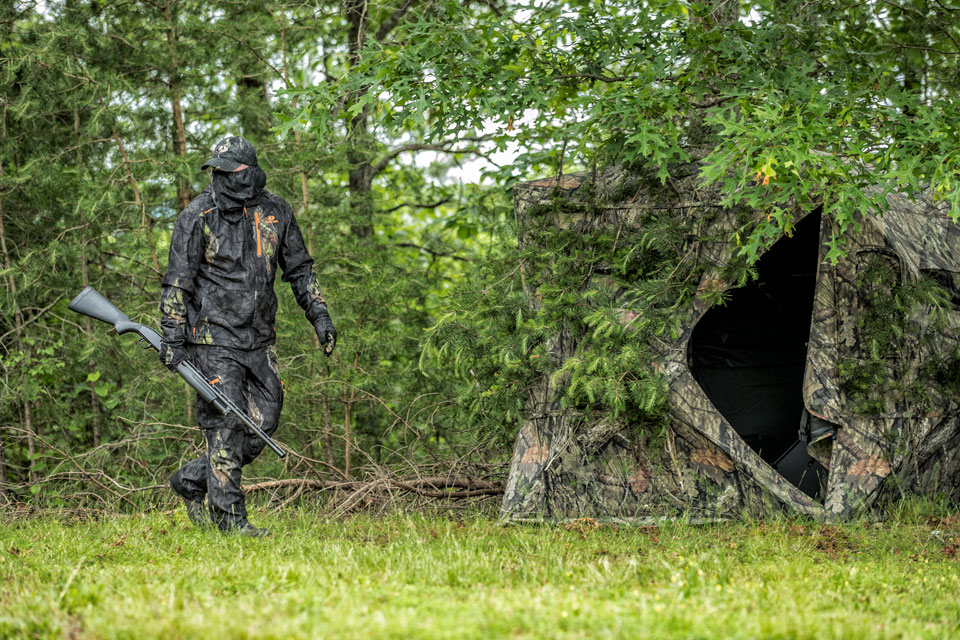
The Best Kinds of Treestands
The most popular style of treestand used to be a traditional fixed position portable, but ladder stands have emerged as the most prevalent these days. One reason is likely because of the increasing average age of the hunting population and the ease of climbing a ladder.
Ryan Knigge of Big Game Treestands from Windom, Minnesota says, “As the hunting market continues to evolve, we see ladder stands continuing to grow in popularity. During the past decade or so, fixed positions had been a more popular way to hunt from above and still are a viable option for many hunters, especially archers. We have continued to see a growing trend of hunters choosing ladder stands over fixed stands. We feel this is due to hunters, especially archers, finding out they can be just as successful using ladder stands. Ladder stands offer a more convenient way to hunt from an elevated position, allowing a hunter more room, comfort, ease of access and added safety. We strive to continue bringing innovative ladder stands to the marketplace.”
Fixed position portables come in rope-on, chain-on, pin-on or belt-on models. They may come with a swivel seat, padded seat, net-seat or chair and may be constructed out of steel, aluminum or other composites. They may also have the option of a fixed platform or leveling platform, in a thick grate or a fine mesh.
Worthy Treestand Accessories
And what about accessories like a foot rest, drink holder, lumbar support or bow-holder? Each variable can have an influence on the performance, weight and safety of each.
These “hang-on” styles of treestands have been around for a long time and they are still very popular with many hunters. Most of today's top treestand companies manufacture hang-on stands that have comfortable seats, large platforms for your feet, and are very light for the amount of weight that they support. When secured to the tree, most hang-on stands are extremely quiet and they are the easiest type of treestand to conceal.
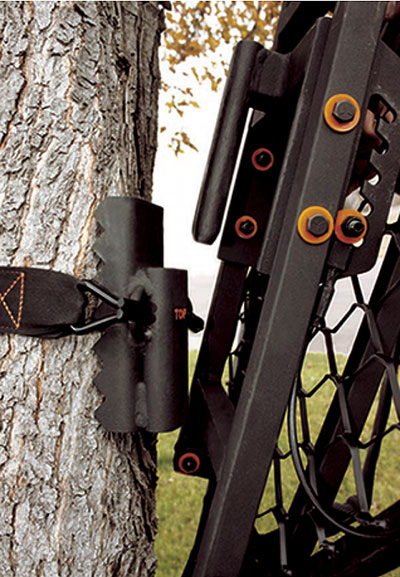
your treestand down and put it back up safely and quickly.
Your platform will be placed back “exactly” in the same
place. It allows you to have fewer treestands that can easily
be moved around to different receiver locations. It’s
especially nice in areas where you experience treestand
thefts.
I like to do some "all day sits," especially during the chase phase and leading into breeding. When the time comes I want a relaxing vantage with a large platform and plenty of room to move around. The older I get, the less of a butt I have, so a large padded seat is also a must. Comfort is probably my most important consideration when purchasing a treestand.
Another extra that has turned into a necessity for me is a platform that can be leveled, like on the Big Game Phoenix or Horizon. In certain parts of the country we have to deal with trees that don’t grow straight. These two powder-coated steel stands feature 60 degrees of adjustable leveling for both, the platform and the seat so you can be parallel to the ground even in a crooked tree.
Fixed Position Portable Treestands
Twisted Timber Treestands out of Mountain Lake, Minnesota specializes in leveling fixed position portable stands that work in just about any tree large enough to support a hunter. A crooked platform, even off a few degrees, can make for a very unpleasant outing and can affect how much time you’re able to put in and even shot accuracy.
A fixed position portable is probably the most versatile type of treestand. With a ladder stand or climber you need the right situation or right type of tree to make your set-up, with a fixed position portable, as long as the tree is big enough to support your weight, there is seldom a spot where you can’t make your set-up.
Out of all the different means to mount your fixed position portable to the tree, a rope-on, belt-on or chain-on model undoubtedly does the least amount of damage to a tree. However, some like the ease of a pin-mounted stand. One can have many pins set up and simply place the stand when you are ready to hunt. Along the same lines is the Hang-On Buddy Tree stand Mounting System. This idea ensures that your platform is placed back “exactly” in the same place each time so shooting lanes won’t need to be changed. It also allows you to have fewer treestands that you can easily move around to all your locations ready to go. This system is especially nice in areas where you experience treestand thefts.
You will also see both steel and aluminum constructed stands. There are pros and cons with each. Aluminum is much lighter but steel platforms seem to be quieter. Steel expands and contracts differently when temperatures fluctuate. Especially in cold weather, I believe a steel constructed stand is much quieter.
Climbing Treestands
I never thought I would ever need a climbing treestand. One reason was in most areas where I hunted you could never find a perfectly straight tree with no limbs on it. Adding to my decision was years ago the first few times I used a climber I felt very UNsafe! Climbing stands have changed dramatically since then — and since then, I have hunted many areas that “do” have many straight trees with no low limbs on them. While hunting “big timber” in areas of Wisconsin and Illinois, or a number of southern states, a climber is possibly the best choice. With one treestand you can go almost anywhere and set up fast and easy.
Over the last two decades, climbing stands have improved considerably. They are now perfectly safe to use, they’re quiet and provide extreme mobility. Most hunters who use climbing stands swear by them because they provide endless options. If you aren’t experiencing action or the wind switches directions, simply climb down the tree, strap the stand on your back and move.
Why Ladder Stands Often Win
Ladder stand sales continue to increase. Many people feel safer with a ladder stand. Not so much safer "in the stand" but, safer climbing the stand because of the ladder. Nine years ago I became a paraplegic due to a fall. No, I didn’t fall out of a treestand. I fell off of my gazebo roof while doing some work and I plummeted 26 feet onto a concrete slab. I can still walk OK with the aid of a cane, but if it were not for ladder stands I don’t think I would be able to hunt from a treestand. Because of my condition I have a very difficult time ascending tree steps or climbing sticks. I literally “thank God” for ladder stands.
I’ve heard the claim that ladder stands are easier to see, both by deer and people, especially people like trespassers and treestand thieves. I would tend to agree that ladder stands are more difficult to camouflage which will generally makes them easier to see. However, I believe that you can be just as effective while hunting out of any type of treestand as long as you create an effective ambush site. Even with the “disadvantage” (if you want to call it that) of “having to hunt out of a ladder stand,” I have had some of my best years since my accident when it comes to mature bucks.
Reasons To Invest in a Quality Treestand
I believe that ladder stands are also the best way to introduce youth to hunting from a treestand. Most kids climb trees like monkeys, but for many this is a new experience. Nearly all kids are familiar with this category. With a dual-capacity stand like this we can sit together yet still have the advantages that hunting out of a treestand provides. It also puts you within whispering distance of the child so that you can answer the hundreds of questions that you’ll get about the miracles of Mother Nature. This 15-foot tall, two-person steel constructed ladder stand features a padded shooting rail that you can adjust so that you can easily shoot a bow out of the stand. This rail makes it feel incredibly safe. It also comes with two four-point full body harnesses for safety. I use this model when I hunt by myself also, I love the space!
Another spot where I find a ladder stand is useful is when hunting maturing clear-cuts or areas of new-growth timber. If the trees are too small to support the weight of you in a fixed portable, many times a ladder stand leaning against one or more of the smaller trees will work fine and still be safe.
Every circumstance is different. In most situations, I like to place my stand as high as I can go in a tree without limiting my shot opportunities. Most ladder stands come in heights from 12 to 18 feet tall. If you wish to go higher, most companies also offer extensions for their ladders. Many companies also offer blinds to conceal the stand and its occupants and umbrellas to protect you from the elements.
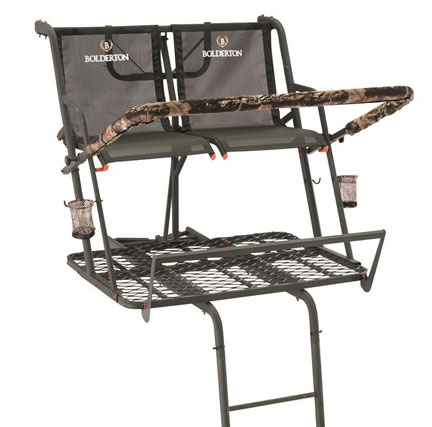
They are easier to ascend and when used properly are just as
effective as any other design.
What happens when there aren't any trees at all to support any type of stand, but there are mature bucks running rampant? For instance, I have several willow swamps, large native grass plantings and CRP areas near my home. Sure, you could use a ground blind but the best answer might be a tripod stand or a free-standing platform. As long as there's enough cover to hide you and the stand somewhat, and the conditions permit, either of these could be the answer.
A tripod gets you up off of the ground so you can see better than while using a ground-blind and your scent isn't concentrated on the same level as that “unbelievable snoot.” Most will also have the option of a blind that will conform to the stand, or if you can get near some small trees or tall brush you can often brush it in so you aren’t silhouetted.
In a situation where there aren’t acceptable treestand trees I really like a free-standing platform combined with a ground blind. In fact, this is a very comfortable way to go regardless of your conditions. It gives you the comforts of a ground blind with the advantages of being elevated off the ground. The Big Game Booster accompanied by a ground blind makes for a great combo. Most standard ground blinds should work with this platform. The more I hunt from this set-up, the more I like it. I’m elevated, but my movement is concealed and with a traditional ground blind I can still easily shoot a bow out of the set-up, as opposed to many box-blind arrangements.
Shooting Houses
Shooting houses or box-blinds are also becoming very popular — again, likely because of the aging population of the average hunter. An enclosed shooting house is warm, comfortable and can usually fit more than one hunter, making it a great choice for introducing youth. Years ago it was impossible to find one that could accommodate a bowhunter, but now many companies are adapting and listening to archers and making units a bit wider and deeper to allow for drawing your bow and the windows longer and lower to be more bow-shot friendly.
Crotchstands
One other stand that is useful once in a while is a crotchstand. A crotchstand, as you may have guessed, is designed to wedge between the crotch of a tree or in-between two trees. When this stand gets used I usually make ready a tree-seat to use in conjunction with it for added comfort.
Treestands Are an Investment
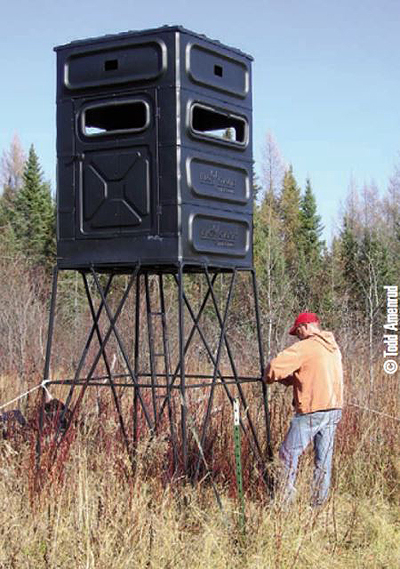
fit more than one hunter, making it a great choice for
introducing youth to pursuing whitetails.
There’s an old saying that you hear often that definitely applies here: “you get what you pay for.” You can typically find a ratchet-strap, fixed position portable treestand for $100 or less. You pay extra for a larger size, added comfort and ease of use. When you look at the difference in styles and consider cost, remember that with a fixed-platform portable treestand you will also need a way to climb up to the base, so you will need to figure in the cost of tree-steps or climbing-sticks — this will run you an extra $80 to $100 to get you 15 to 18 feet off the ground. With that in mind, now the cost of a ladder stand is looking much more comparable. Most of the other styles of treestands come with a way to climb included in the price, as with a ladder stand, tripod, stand-alone platform or even a climber.
If a person likes to have multiple setups ready to play different conditions or if they hunt multiple areas, then an inexpensive, fixed position portable probably makes the most sense. If you like to put in long hours or possibly like to hunt all day, then I would suggest paying a bit extra for a large platform and some extra comforts. The one thing I learned in doing this article is that it seems like the companies that have been successful and survived the consolidation over the last decade, listen very carefully to their customers and are quick to react when they have a better way to do something or discover a need from their customers that isn’t being met.
The price of treestands can vary from $50 to $1,000 or more. Some make their buying decision because of the “name” and some buy on price. Maybe your terrain or your specific situation dictates to you exactly which style of treestand you must go with. If you choose a stand that makes you feel safe and select the proper accessories to aid in making you more efficient, you'll be on your way to harvesting more deer, bigger bucks and maybe that trophy of a lifetime.














